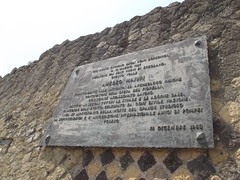Amedeo Maiuri
Amedeo Maiuri
(1886-1963)
Commemorated on 1 plaque
Qui limite estremo degli Scavi Borbonici. Il 18 Maggio 1927 iniziarono gli Scavi Nuovi di Ercolano. Questo volle Amedeo Maiuri Soprintendente alle antichita ed archeologo insigne continuatore dell'opera del Fiorelli. Con tenace appassionato lavoro restitui ai secoli futuri le strade e le Adorne Case. In ricordo dell'evento, celebrato da ogni civile nazione. Nel XX anniversario della morte del grande studioso la soprintendenza e l'associazione internazionale amici di Pompei posero 18 Dicembre 1983
English translation:
Herculaneum, Ercolano, Italy where they is commemorated

